KLH Model Five Loudspeaker Review

KLH Model Five Loudspeaker Review
By: Thomas J. Norton | Oct 20, 2021
PRICE $2,000/pair
AT A GLANCE
Plus
Clean, uncolored sound with solid bass
Cool vintage looks
Three-way switch to modify mid- and high-frequency output
Minus
Best sound with grilles off
THE VERDICT
The new, re-imagined KLH Model Five represents an exceptional update to an iconic speaker design.
KLH was originally founded in 1957 as the KLH Research and Development Corporation by three partners: Henry Kloss, Malcolm S. Low, and Josef Anton Hofmann. Today, the best-known of that trio is the late Henry Kloss. A true A/V renaissance man, Kloss was instrumental in establishing four loudspeaker companies: Acoustic Research, KLH, Advent, and Cambridge SoundWorks. In the mid-1970s, he also founded a short-lived company to market his then-revolutionary Advent VideoBeam projection system. Kloss further worked to improve FM radio and brought Dolby B noise-reduction to the consumer audio cassette.
When Indiana-based Kelley Global Brands bought the rights to the KLH name in 2017, it took on the significant challenge of reviving a long-idled loudspeaker brand. The first step for the company was to release a lineup of new KLH loudspeakers. While well received, none of these had a direct connection to the originals—understandable, since loudspeaker design has advanced significantly since KLH’s glory years. But there’s still plenty of love in the audio world for classic speaker and component designs, and the Model Five is about as classic as they come.
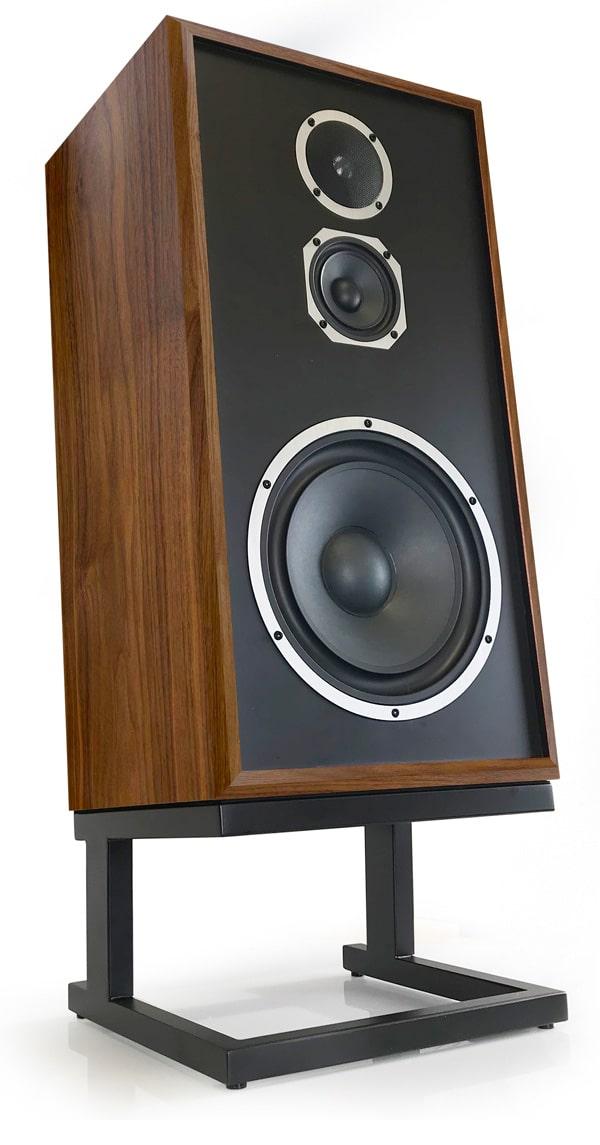
Acoustic Suspension
KLH designs of the ’60s used the then-rare acoustic suspension technology developed and patented by Edgar Villchur, the founder of Acoustic Research (AR), a company that Kloss had assisted in launching. Kloss left after a year or two and licensed the acoustic suspension design when he started KLH.
Ported loudspeakers of the 1960s were big and largely “cut-and-try” since repeatable criteria for optimizing their design didn’t yet exist. Villchur’s invention of acoustic suspension might not have been as revolutionary as Philo Farnsworth’s cathode ray tube (which made television possible), but it turned loudspeaker design on its… um…ear. Simply put, acoustic suspension relies on a woofer with a suspension too floppy to work in other types of designs. Instead, the compression of the air inside its relatively small, sealed cabinet acts as a spring to keep the woofer under control. The result was surprisingly powerful bass from a cabinet far smaller than conventional designs of the 1960s.
With the eventual development of detailed design guidelines for ported speakers, and (eventually) readily available computer tools to optimize them, fewer speakers today use acoustic suspension. So why use it here? The most obvious reason is the classic element: You can’t make a speaker a ported design and call it the “KLH Model Five” with a straight face. But there are also performance reasons for choosing acoustic suspension, among them the fact that an acoustic suspension loudspeaker rolls off at 12dB/octave below its designed driver/box resonance. (A ported design in contrast rolls off at 24dB/octave below its port resonance.)
A multitude of other variables are involved. Ported speakers can be a bit more efficient, but not always. They have a reputation among audiophiles for boomy bass, though given a good design that point is arguable. You won’t find audiophiles either clinking our glasses or holding our noses over acoustic suspension. It’s simply a valid design choice, enhanced in this case by a bit of nostalgia.
Features
The new KLH Model Five closely resembles the ’60s version, though with some differences. Its 3-way driver complement consists of a 1-inch aluminum dome tweeter, a single 4-inch pulp paper cone midrange driver, and a 10-inch pulp paper cone woofer. The crossover frequencies are 380Hz and 2.85kHz, both second order, and the midrange is housed in its own enclosure inside the main cabinet.
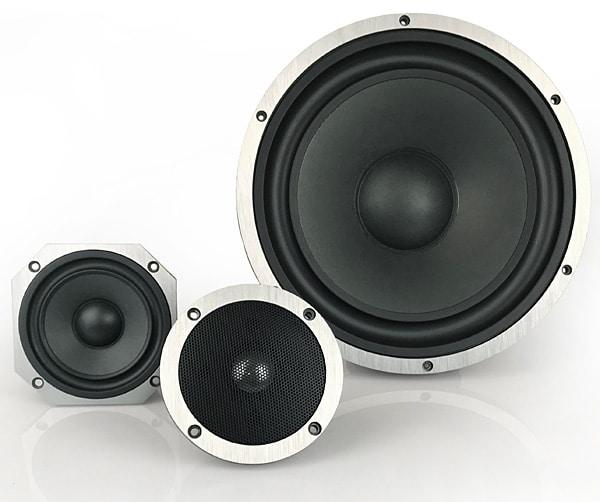
Loudspeaker drivers are far better today, and more strategically deployed, than they were a half-century ago. The old Model Five used a pair of 5-inch midrange drivers mounted side- by-side. (No one apparently worried at the time about the uneven horizontal dispersion due to comb-filtering that side- by-side drivers generate.)
I once read that during KLH’s wilderness years Henry Kloss deliberately selected a tweeter for the original Model Five with less high-frequency extension than the best tweeters then available out of concern that the clarity might reveal the harshness he experienced in many recordings of the time. That story may be apocryphal, but either way I doubt this was one of the design decisions made for the new Model Five!
Wide speaker cabinets have long gone out of style, but with a woofer identical in size to the original, that design choice was unavoidable here and makes for a cabinet with a near 14-inch width. But I heard no audible issues related to this, nor from the small, possibly diffraction-generating, lip visible around the front baffle with the speaker’s grille removed.
The Model Five’s cabinet is finished in a West African Mahogany (English Walnut is a second option) real wood veneer complemented by a linen grille. Lighter-colored linen grilles are available for an extra $200 but I found the stock version to be perfectly acceptable. The speakers are more attractive with their grilles in place, but they sound (and measure) better with them off. A pull tab at the bottom allows for easy removal, and the grilles can be reinstalled via the hidden magnets that hold them in place. (Velcro was used for this purpose on the original.)
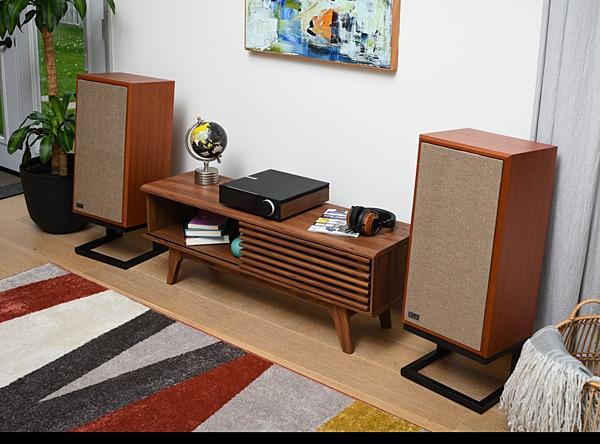
Around back is a single pair of 5-way binding posts. The rear panel also includes one other carryover: a three-way switch designed to slightly increase or decrease the mid- and high-frequency output. The neutral position is Hi, Mid provides a reduction of 1.5dB, and Low a 3.0dB cut. While this is not exactly intuitive, it’s reportedly the same configuration used on the originals. For me, the Mid position worked best.
The Model Fives are too big for a standard tall speaker stand and too short to function as a freestanding tower. Fortunately, they come with short stands that tilt the speakers slightly backward to aim the drivers’ radiation pattern at a seated listener. There’s no way to solidly fasten the speakers to the stands; the 44-pound weight does mean that gravity will keep them secure, but it’s not possible to easily “walk” them around on the floor to tweak for the best setup position. There’s also no provision for spiking the speakers and stands to the carpet (spikes are an audiophile trend that hadn’t yet caught on in the ’60s).
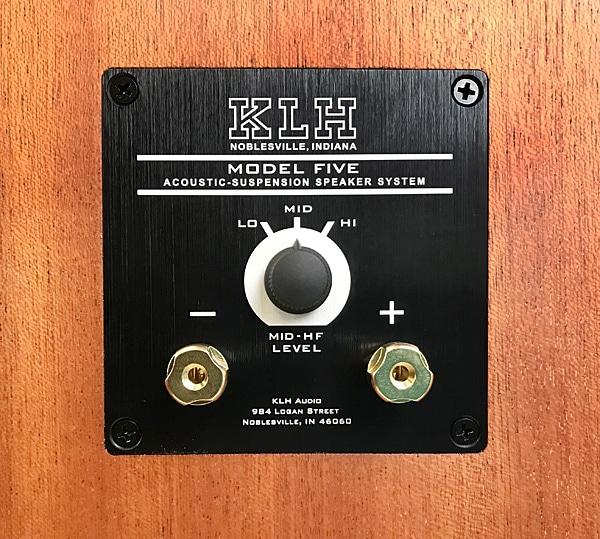
One other way the new Model Five differs from the original is that it isn’t made in Cambridge, Massachusetts. While each component of the new design has been custom-engineered by KLH’s Kerry Geist, like most of today’s reasonably affordable loudspeakers (and even some not-so-affordable ones) they’re manufactured in China.
Setup
I set the Model Fives up about 9 feet apart and roughly 4 feet out from my room’s back wall, angling them in at the primary listening seat. The tilt of the included stands allowed for the tweeters to be aimed approximately at my seated ear height. I initially used a Denon AVR- X6700H receiver for my setup, and it performed extremely well with the KLHs. But to feed them a little more power, I ended up using the Denon’s left and right preamp outputs to drive two channels of a Parasound Halo A52+ multichannel power amp. All music used for my evaluation was from CDs played on a Marantz UD7007 player.
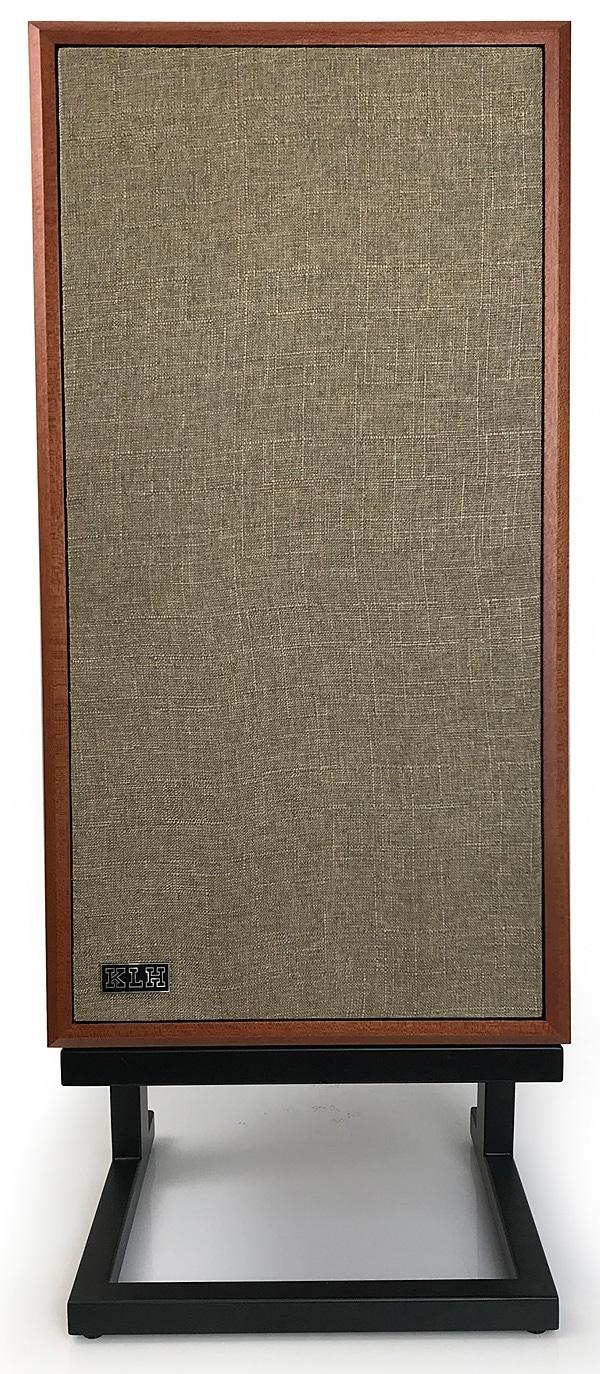
As I’ve mentioned in previous speaker reviews, my very large room provides less than ideal deep bass support for full-range speakers. It also adds modal peaks between 100Hz and 200Hz as measured at the listening position. The only method I’ve found to correct these issues is room EQ.
But before going there, I first spent time with the Model Fives driven full-range without EQ of any sort. The low end was enticingly tight and punchy, particularly the high overtones that lend character to drums, organs, and synthesized bass in electronic music. But I wasn’t hearing the true weight of these instruments in my room. If EQ could be added to fill out the low-bass balance without adverse side effects, that would be a strong indication that the speakers themselves, in a smaller room than mine, would have what it takes to deliver the full frequency range. (Apart, of course, from below 30-40Hz— subwoofer territory—which is exceptionally rare with any standalone loudspeaker.)
To free the Model Fives (as much as possible) up from my room’s bass issues, I used Denon’s Audyssey MultEQ XT32 EQ, applying it only below 300Hz. The Model Fives were left untreated by room EQ above that frequency. (For more on the whys and wherefores of this, see my review of the PSB Synchrony 600T tower loudspeaker.) Most bass problems (apart from a speaker’s low-end limitations and distortion) below a given frequency are caused more by the room than the loudspeaker. The issues will depend on the characteristics of room itself, but typically occur below 200-500Hz.
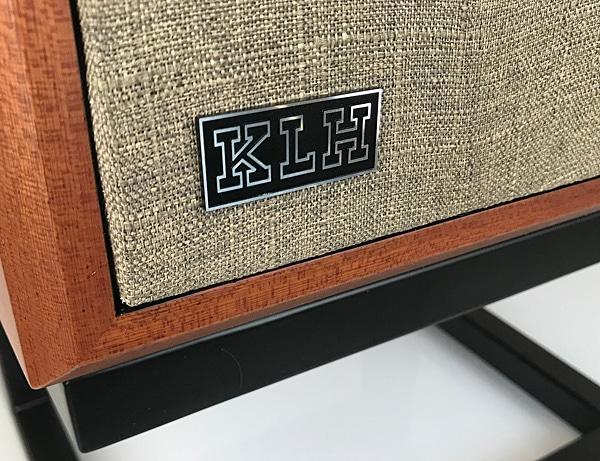
Audyssey had to apply a significant bass boost to the Model Fives to provide useful bass extension in my room, so I also used the app’s flexible target function to dial in a sharp roll-off below 40Hz. This let them provide useful output to under 40Hz, which is KLH’s approximate low-end frequency response spec for the Fives.
Performance
Recall what I said above about the original KLH Model Five featuring a tweeter that was selected based on its limited high-frequency extension? That’s not the case with this version at all. No one will ever accuse the new Model Five of being a shrinking violet when it comes to detail and dynamic range. In fact, the KLH might not be an ideal choice for listeners who prefer a richer sound with subdued detail, because this tweeter reveals everything.
You wouldn’t expect explosive dynamics from a recording that begins as little more than Baroque chamber music, but Gregorio Paniagua’s La Folia de la Spagna (Harmonia Mundi, 1982) is something very different. It might be better described as a chamber concert with a heavy helping of Spike Jones. After a few sedate minutes the music is suddenly punctuated by startling percussion riffs, cars, church bells, buzz saws, and even the musicians occasionally chattering among themselves. The Fives handled all of this with ease, effortlessly rendering the recording’s huge dynamic range and precise soundstage.
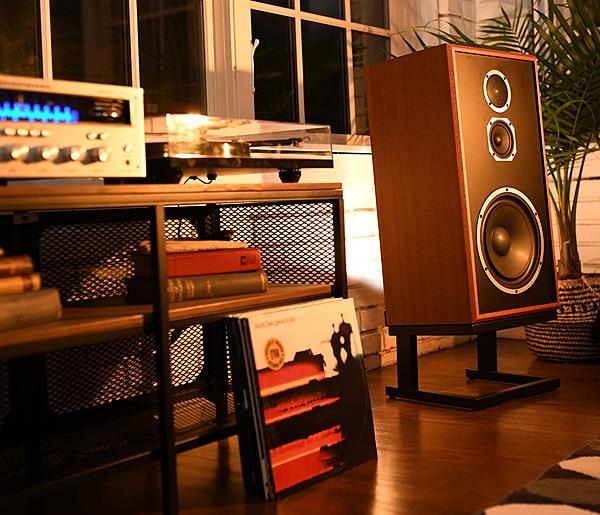
The Model Five also excelled on female vocal recordings. Sophie Zelmani’s “How it Feels” (from the album Sing and Dance) and Sinne Eeg’s “My Treasure” (from Waiting for Dawn) both sounded warm, smooth, and uncolored, with just the right touch of the sibilance that’s typical for pop recordings due to close-miking.
Listening to Dead Can Dance’s In Concert, the ambience of the venue, together with the audience reactions, were clearly sculpted by the Model Fives. The soundstage wasn’t pinpoint, but this was clearly the intent for the recording’s mix and no shortcoming of the speakers, whose abilities in that regard had already been convincingly demonstrated. In Concert was accurately presented by the Model Fives as a huge sonic bubble. If the experience wasn’t exactly as enveloping as what a surround sound system might offer, it was nevertheless big, rich, and highly involving.
The Model Five’s bass won’t tempt you to you sell your subwoofer, though I did find it satisfying on music. Recordings of Japanese Taiko drums sounded hard-hitting, without mud or boom. And while it was clear that the KLHs wouldn’t rattle the teacups in my kitchen when I popped in a good recording of Bach’s Toccata and Fugue in D-minor (Jean Guillou, Dorian Recordings), it was also true that their bass would engage all but the most rabid organ fanatics.
This isn’t a review of a surround-sound speaker package, but I did do some movie viewing using the Model Fives with no subs, a phantom center, and a pair of small surrounds. The results were mixed depending on the source, but I had to tread carefully with a bass-heavy title like Blade Runner 2049, dialing back the Denon’s volume and bass controls to avoid eliciting rude or even disturbing noises from the woofers. All this will depend very much on the size of your room (and how much, if any, room EQ you require), but if you regularly watch bass-heavy movies, the Model Fives alone will be no substitute for one or more good subwoofers.
Conclusion
I enjoyed the many hours I spent listening with the KLH Model Fives. Is it the perfect loudspeaker? The tweeter in the new Model Five is likely to be far more revealing than the one found in the original, so if your taste leans toward warm and forgiving sound, this might not be the best choice. But if you want to hear all the detail present in well-produced music, along with fulfilling, dynamic performance across the full frequency range, you won’t be disappointed.
Specs
10 in pulp paper cone woofer, 4 in pulp paper cone midrange, 1 in aluminum dome tweeter; available finishes: English Walnut or West African Mahogany, both with 13.75 x 34.25 in (with included riser base, 26 in without base) x 11.5 in (WxHxD); 52 lb (with included riser base, 44 lb without base)
KLH Model Five Loudspeaker Review Test Bench
Test BenchThe results shown here were conducted in my room using the Parts Express Omnimic measuring software and microphone, taken at the main listening seat about 10 feet from the speakers with the latter on their included stands and angled in to directly face the microphone.
All the measurements were taken at the single, seated, ear-level position. (Experience in my room has shown that an average of several readings, taken across a span of about 2 feet, differs little from the single-position measurement apart from smoothing out small ripples.) All curves here are 1/6th octave smoothed and are for the Model Fives alone with no subwoofer.—TJN
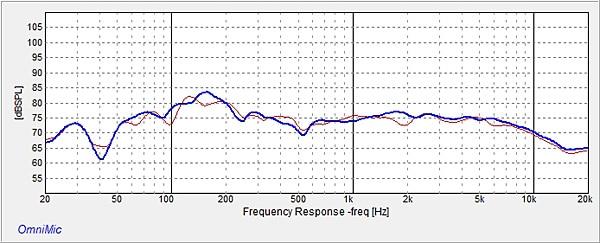
Raw in-room response in the left (red) and right (blue) channels with no equalization (Audyssey EQ, tone controls, or graphic EQ).

Left channel only, with no room EQ (red) and with Audyssey room EQ activated only under 300Hz (blue). Note that the responses overlap perfectly above 300Hz (250Hz, actually), confirming that, as intended, the Audyssey EQ response corrections are all below that frequency.
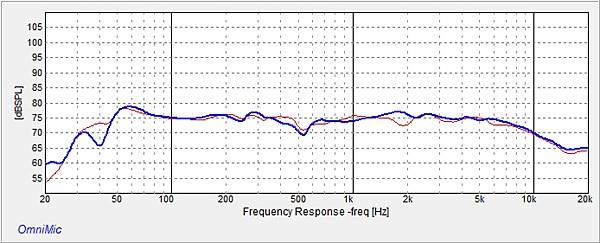
The in-room responses of the left (red) and right (blue) channels with Audyssey room EQ engaged below 300Hz.